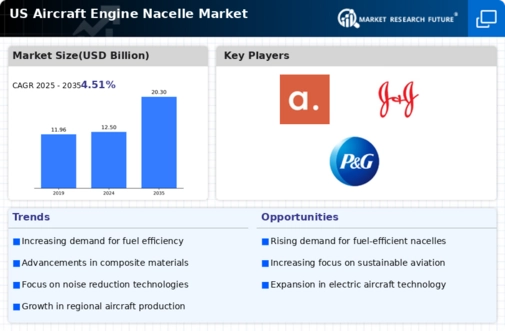Emerging Markets and Globalization
The aircraft engine-nacelle market is influenced by the dynamics of emerging markets and globalization. As economies in regions such as Asia-Pacific and Latin America grow, there is an increasing demand for air travel, prompting airlines to invest in new aircraft and nacelle technologies. This trend is likely to create opportunities for manufacturers in the aircraft engine-nacelle market to expand their reach and diversify their product offerings. Additionally, globalization facilitates partnerships and collaborations, enabling knowledge transfer and innovation. The market may see a rise in joint ventures aimed at developing next-generation nacelle systems that cater to the specific needs of diverse markets, thereby enhancing competitiveness.
Increased Demand for Fuel Efficiency
The aircraft engine-nacelle market experiences heightened demand for fuel efficiency as airlines seek to reduce operational costs. With fuel prices representing a substantial portion of airline expenses, the push for more efficient engines and nacelles is paramount. Recent studies indicate that improvements in nacelle design can lead to fuel savings of up to 15%. This trend is further driven by regulatory pressures aimed at reducing carbon emissions, compelling manufacturers to innovate. The aircraft engine-nacelle market is thus witnessing a shift towards lightweight materials and advanced aerodynamics, which are essential for enhancing fuel efficiency. As airlines increasingly prioritize sustainability, the market is likely to see a surge in investments directed towards research and development in this area.
Technological Innovations in Materials
Technological innovations in materials are transforming the aircraft engine-nacelle market, as manufacturers seek to enhance performance while reducing weight. The introduction of composite materials, such as carbon fiber reinforced polymers, is becoming increasingly prevalent. These materials offer superior strength-to-weight ratios, which are crucial for improving fuel efficiency and overall aircraft performance. The aircraft engine-nacelle market is witnessing a shift towards these advanced materials, which can potentially reduce nacelle weight by up to 30%. This trend not only supports fuel efficiency goals but also aligns with the industry's broader sustainability initiatives, as lighter nacelles contribute to lower emissions and operational costs.
Growth in Air Travel and Fleet Expansion
The aircraft engine-nacelle market is poised for growth due to the increasing demand for air travel and subsequent fleet expansion. As the economy strengthens, airlines are expanding their fleets to accommodate rising passenger numbers. Projections indicate that the commercial aviation sector will require over 40,000 new aircraft by 2035, which directly impacts the demand for nacelles. This growth in the aircraft fleet necessitates advancements in nacelle technology to ensure optimal performance and efficiency. The aircraft engine-nacelle market is thus likely to benefit from this expansion, as manufacturers strive to meet the needs of airlines for more efficient and reliable nacelle systems.
Regulatory Compliance and Emission Standards
The aircraft engine-nacelle market is significantly influenced by stringent regulatory compliance and evolving emission standards. Authorities such as the Federal Aviation Administration (FAA) and the Environmental Protection Agency (EPA) impose regulations that necessitate the reduction of greenhouse gas emissions from aircraft. As a result, manufacturers are compelled to develop nacelles that not only meet these standards but also enhance overall engine performance. The market is adapting by integrating advanced technologies that facilitate compliance, such as noise reduction systems and improved thermal management. This regulatory landscape is expected to drive innovation, with investments in cleaner technologies projected to increase by approximately 20% over the next five years, thereby shaping the future of the aircraft engine-nacelle market.














Leave a Comment